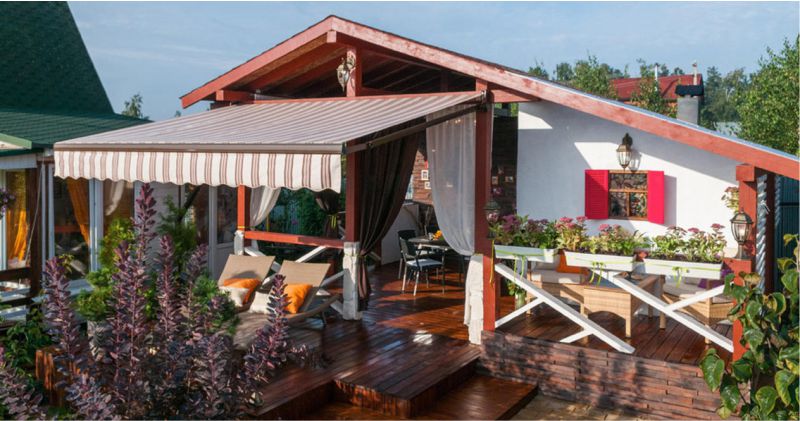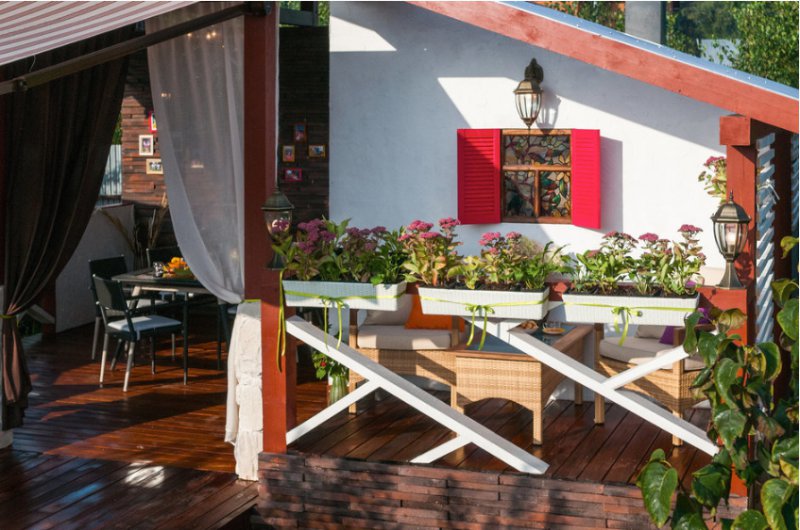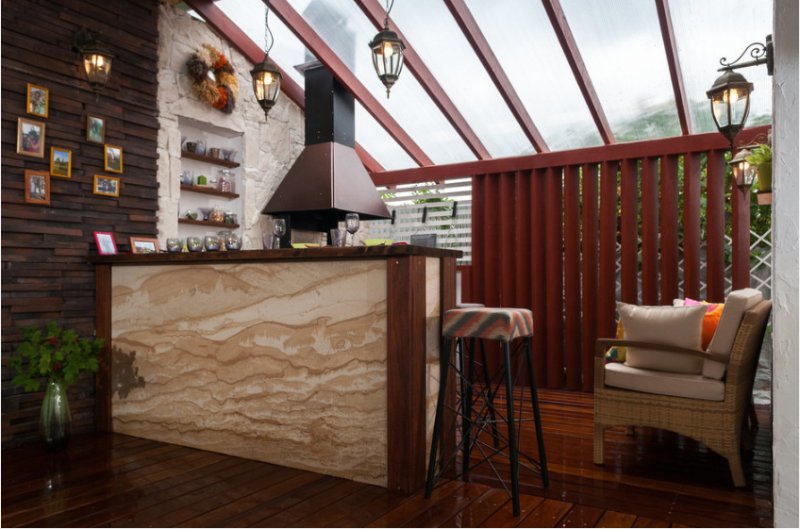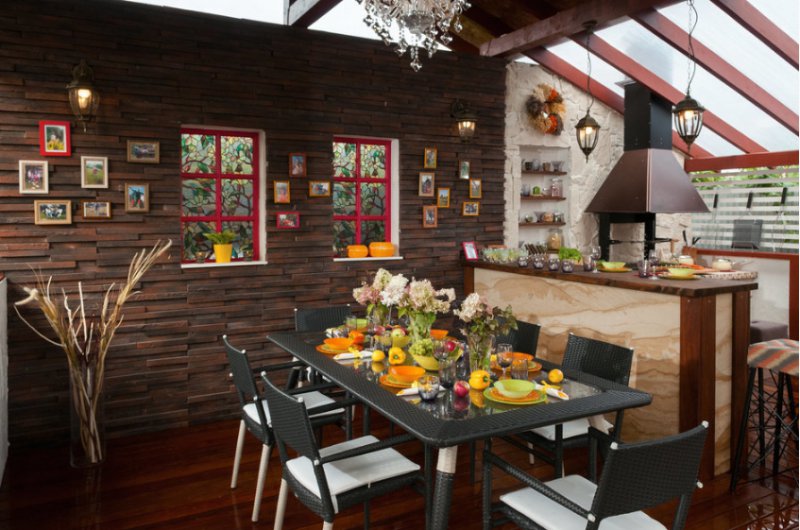
A summer kitchen, whether it’s a simple gazebo with a barbecue or a solid structure with an oven makes a great addition to any home. After all, summer life is inconceivable without barbecues and fun outdoor gatherings. In this article, we present 11 tips, 70 photo-ideas and several videos that will help you create your perfect summer kitchen.
What are the different types of summer kitchens?
They can be divided into three types:
-
Open (for example, a gazebo-barbecue, terrace or patio)
This is a simple frame structure without insulation, often without walls (completely / partially) and even a roof. In fact, an open summer kitchen is a canopy or a gazebo with a barbecue / oven and a dining area, which can only be used in the summer. It is advantageous in that it is comfortable and easy to cook in, as well as easier to communicate with guests in the garden on fine summer days. An open kitchen is easier, faster and more economical to build than a closed one. In the winter, a summer kitchen building with a canopy can be used as a storage for unnecessary items. Disadvantages of the open kitchen can be listed as a limited period of use of the structure, as well as the lack of protection of furniture, appliances and the inhabitants of the kitchen from insects, rain, wind and sun. For the winter, all furniture and equipment will have to be stored in a dry room.

-
Closed (for example, a grill house or a veranda)
It is a large covered building with an annex with insulation and glazing, sometimes even heated all year round. In fact, this is a real house, consisting of a kitchen and a dining room. A closed summer kitchen is good in that you can cook and dine in it even in bad weather, such as when there is rain and wind. Thanks to the walls and roof in this house, you can equip a full kitchen, complete with a refrigerator, microwave, gas / electric stove , dishwasher , TV and other appliances . However, during warm days, cooking in a closed kitchen will be just as hot as doing so in the main house. Also, keep in mind that its construction will cost you more than construction of an open kitchen.
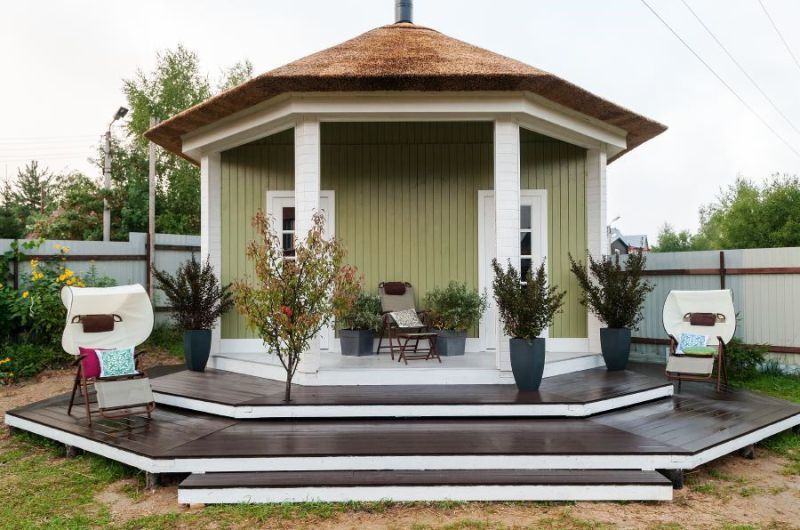
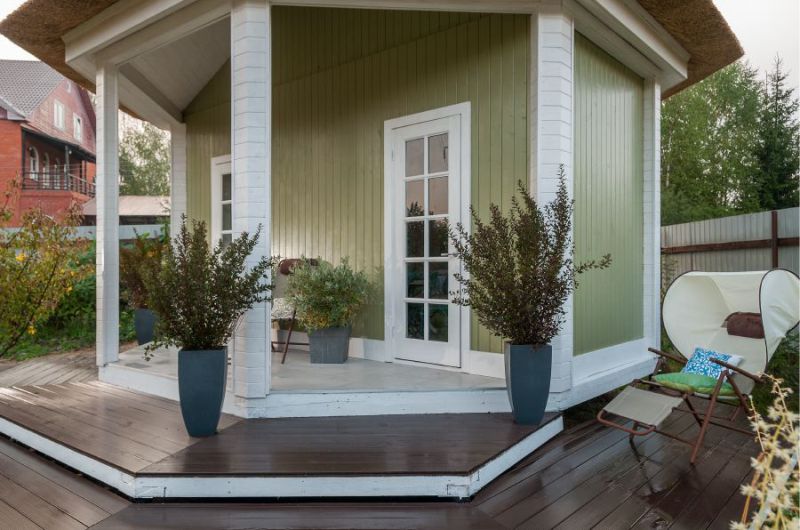
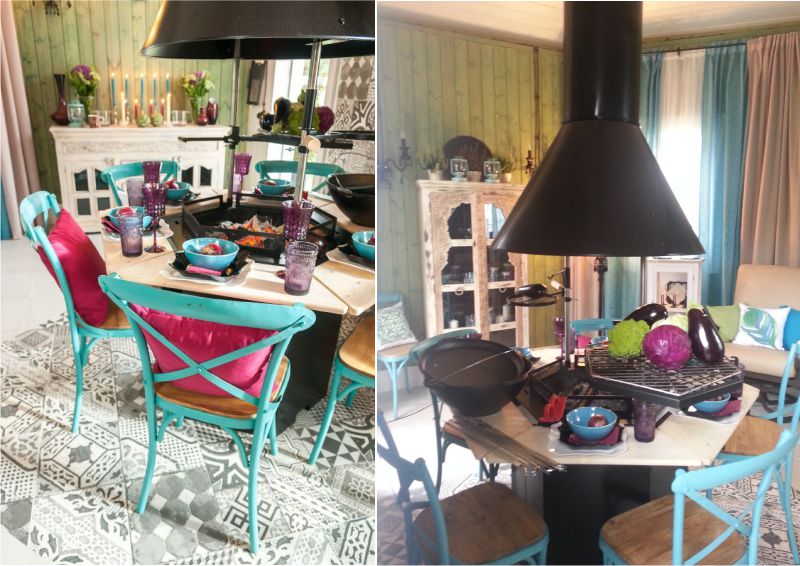
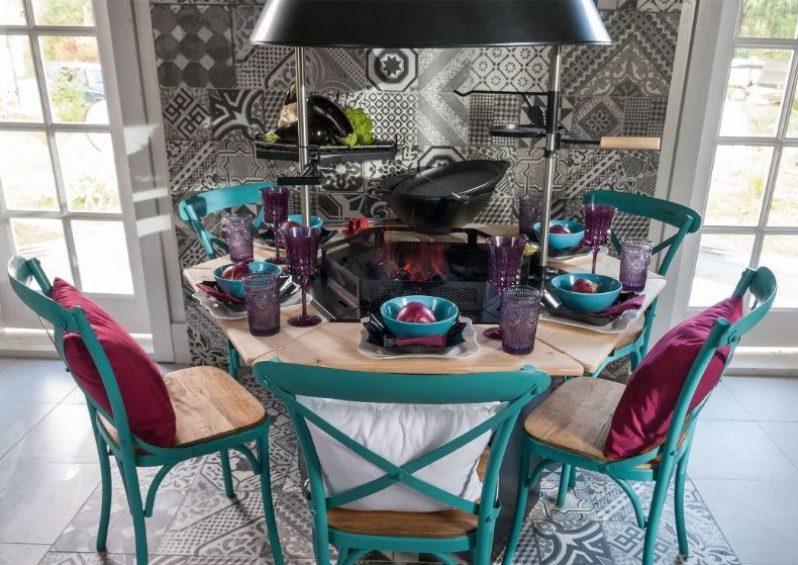
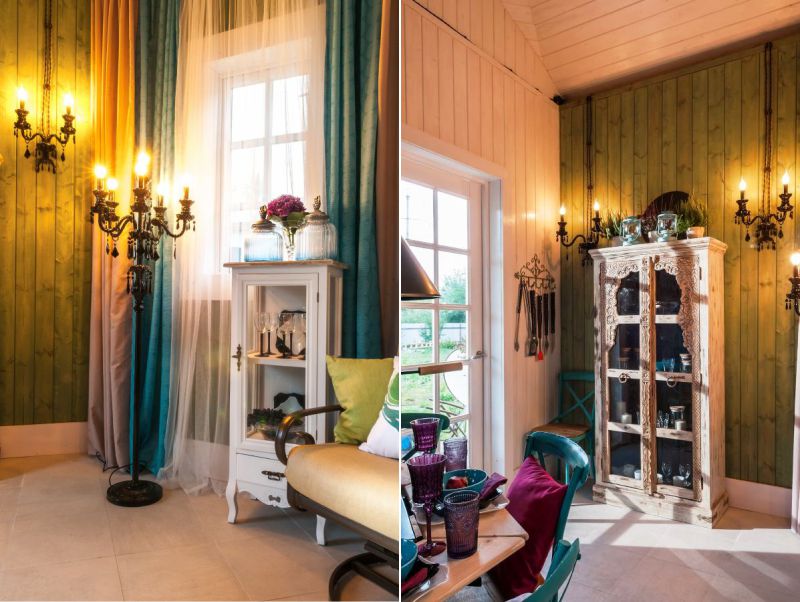
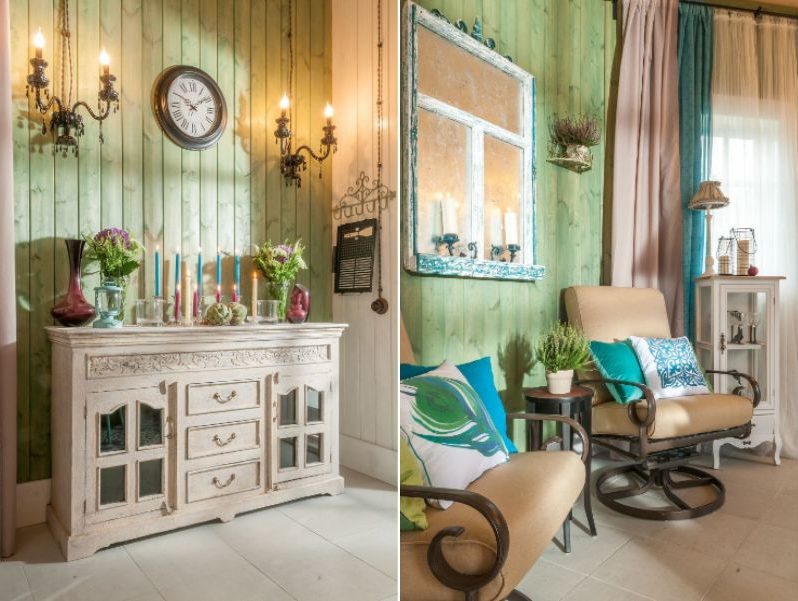
-
Combined
This type of summer kitchen design combines under one roof an open and covered room. Also in this category, a summer kitchen can be combined with a bath. Such a kitchen is good for everyone and has only a couple of disadvantages – doubly complicated design and increased budget.
Now let’s look at the characteristics of separate and attached kitchens:
- Separate– Advantageous in that you can place the hearth away from the main house, so that smells, smoke and noise do not penetrate into the house. Building a detached summer kitchen makes sense if you have enough space on the site, if it has, say, a beautiful garden or pond, or if you want to decorate the territory with a new pretty building.
- Adjacent to the house– a terrace or veranda can become an excellent summer kitchen, because it is much easier and cheaper to build (one wall is already erected) or re-equip. Movement between the house and the annex is also very convenient. The downside of a summer kitchen on the veranda / terrace is that smoke, heat, smell and stains from the stove will enter the living quarters, and part of the kitchen will remain open.
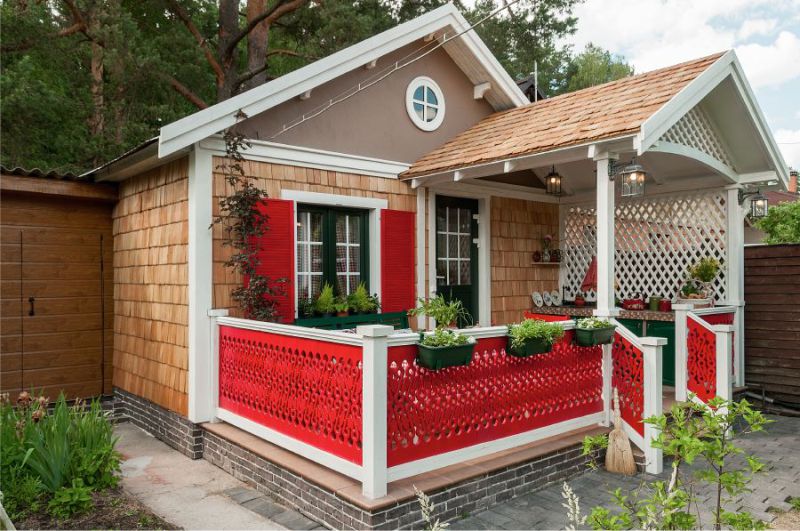
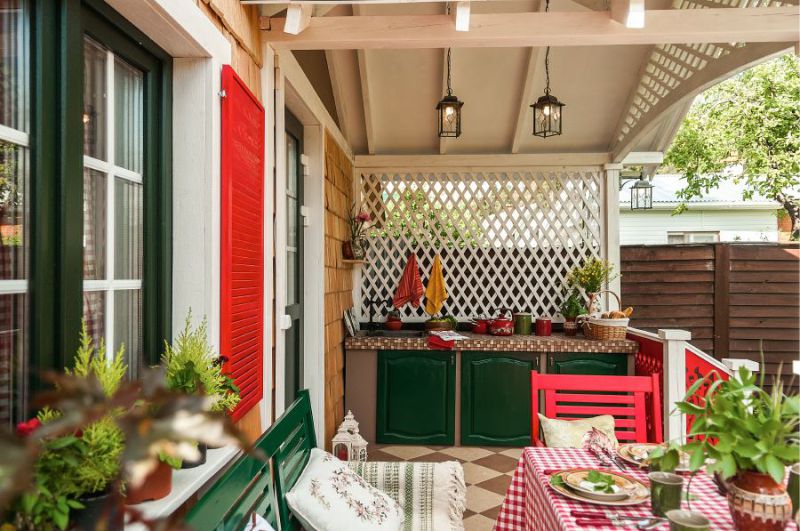

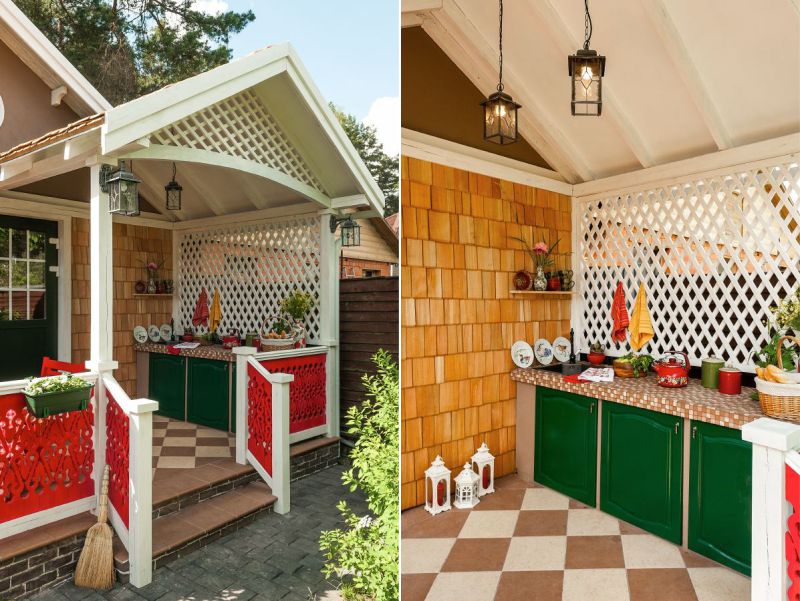
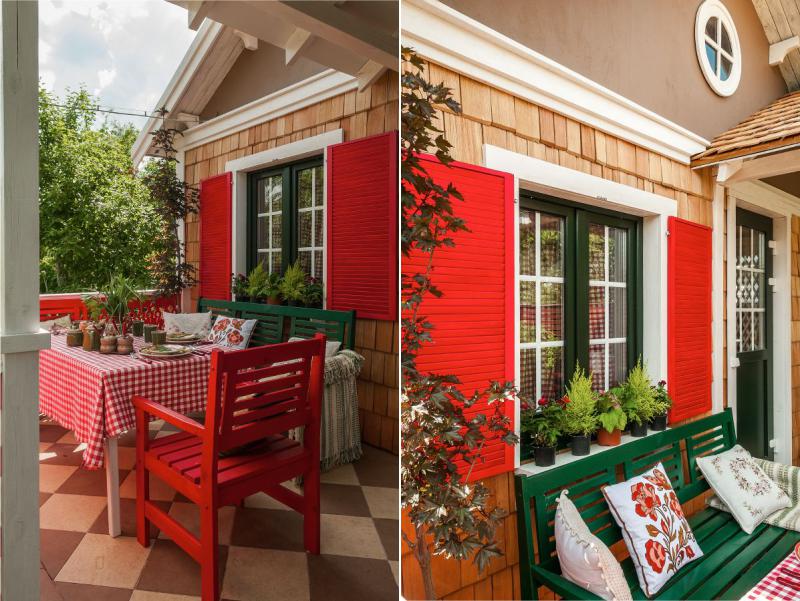
11 tips for building, arranging and designing a summer kitchen
Tip 1. Choose the best place
No matter how thoughtful and beautiful your summer kitchen design might be, choosing a bad location on the site can complicate construction. Therefore, the location is the first factor to think about.
- From a practical point of view, it is more convenient when a summer kitchen is located near the house, so the inhabitants move and communicate more easily and conveniently.
However, from an aesthetic point of view, a better place would be near the “attractions” of the site, where you can admire good views (for example, near a pond or garden). Also bonus factors to consider include: protection from wind, solitude from neighbors’ eyes and proximity to trees that will be able to protect the building and create a shade in the hot days.
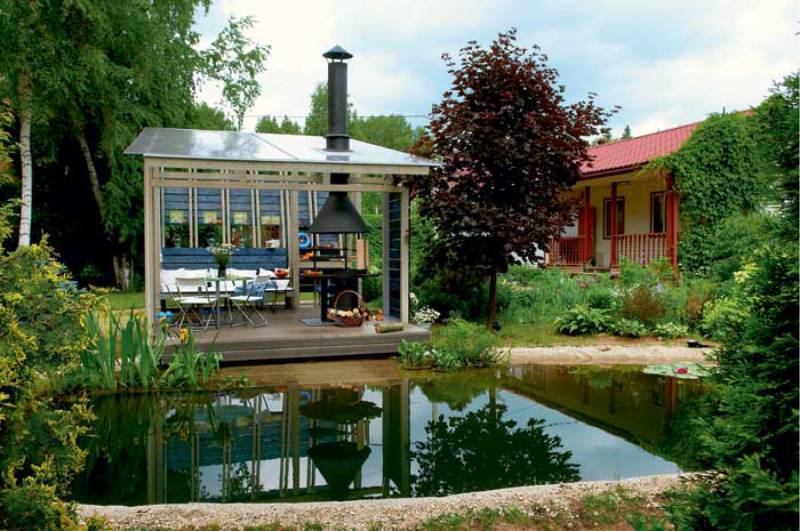
- Unsuitable places for summer kitchen are: near the road, garage, toilet, cesspools / compost pits, chicken coop and other places where your rest can be prevented by unpleasant odors, noises, exhaust fumes, etc.
Tip 2. Grill, oven or oven complex? Solve this issue before developing / embarking on a summer kitchen project
- If the stove is the heart of the city’s cuisine, then the grill, brazier or stove can be called the heart of the country kitchen.Before you start designing, think what kind of hearth you need: a grill, a brazier, an oven or a furnace complex? Is the grill stationary or portable? On coal or gas? With a chimney or without? What is the size and location of the source of fire? Your choice determines a lot – from the type of foundation to the shape of the roof. So, for example, for the erection of the furnace, you will have to take care of not only the foundation, chimney and facing, but also to provide in a place for storing firewood.
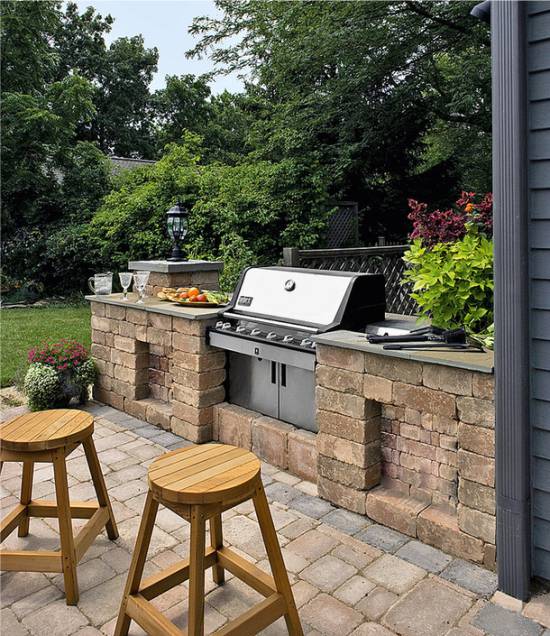
Tip 3. Want to build a summer kitchen yourself quickly and cost-effectively? Build an open pergola made of wood, with a light roof, without the walls and the stove
In this case, instead of a monolithic or pile-and-tape foundation, a columnated foundation can be worked with. The construction itself will consist of 4 (or more) supports and one- / two-slope roof with light material, for example, polycarbonate. This is a very simple design, which you can really build with your own hands in just a couple of days and with a minimal budget.
In the next selection of photos are presented options for the design of simple summer kitchens.
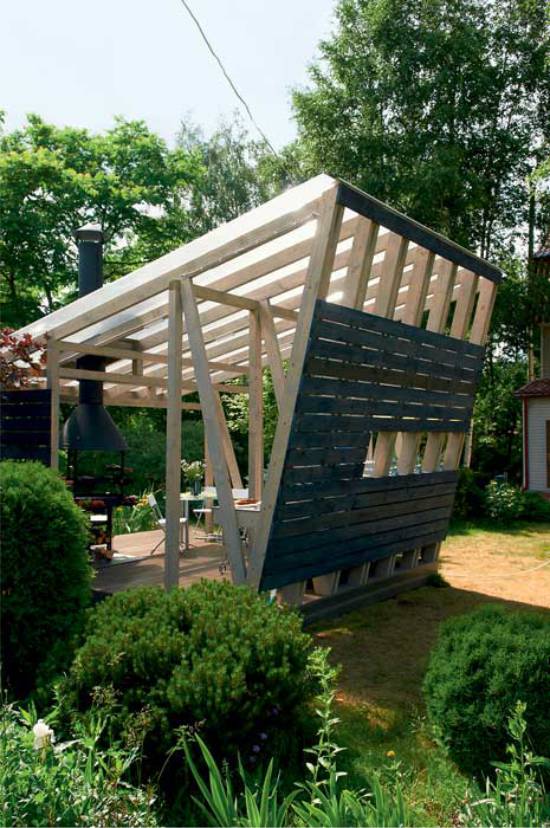
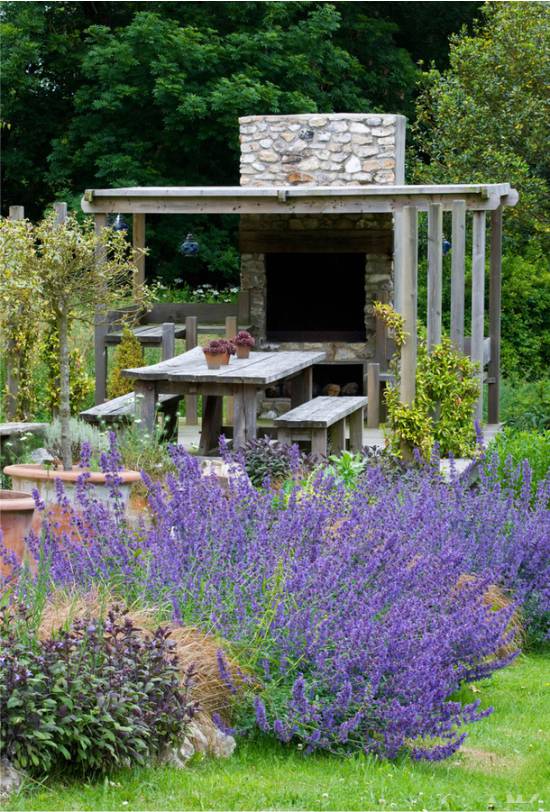
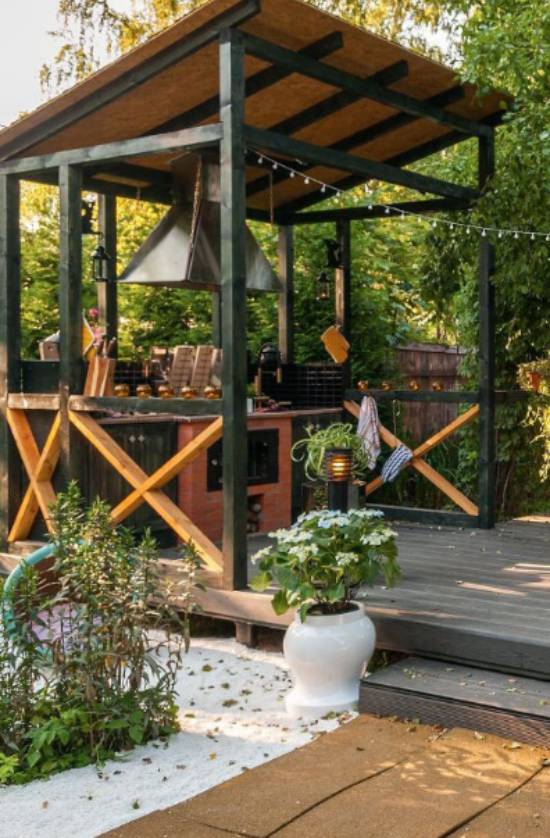
Tip 4. The presence of a cellar is not always justified
On the one hand, a cellar in the summer kitchen is very useful, because it is so inconvenient to store food in the refrigerator. On the other hand, its creation significantly increases the cost and complexity of construction, especially if it is an open design, because then the cellar will have to be insulated and protected from leaks. Even in the main house one can do without a cellar, so it is not really necessary in the summer kitchen.
Tip 5. The summer kitchen, the facade of the house and the landscape should be decorated in a single key
When choosing or developing a draft of the summer kitchen and thinking over the options for its decoration, keep in mind that it should be combined with the facade of the house and other buildings on the site. This will enable you to create a real dacha complex and achieve a sense of order. It is not necessary that there is a 100% coincidence in color, decoration, architecture and style, but objects must echo each other. Below is an example of a modern summer kitchen on the terrace of a wooden house, with a bar.
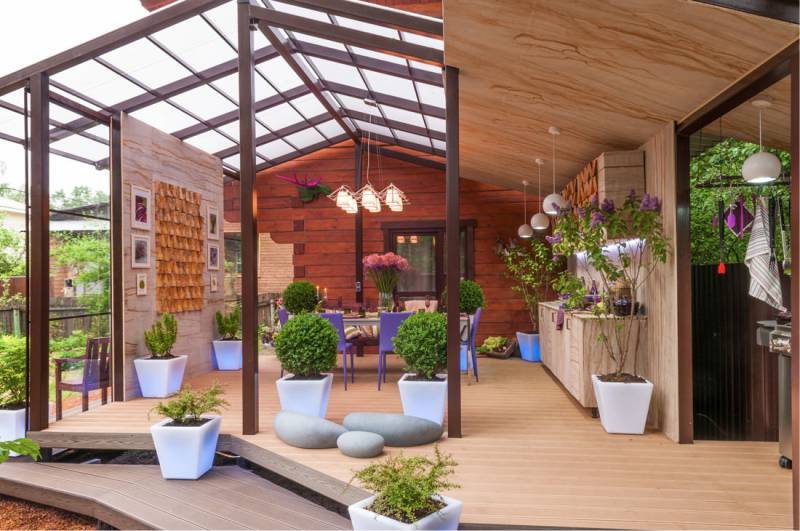
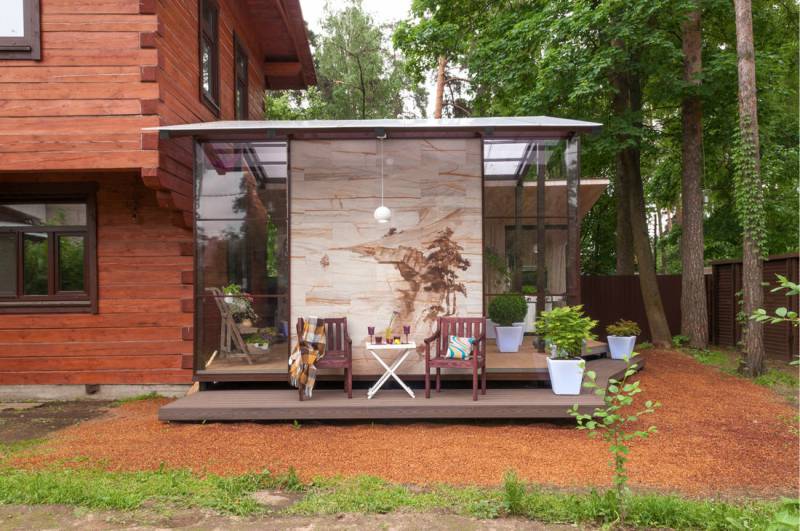
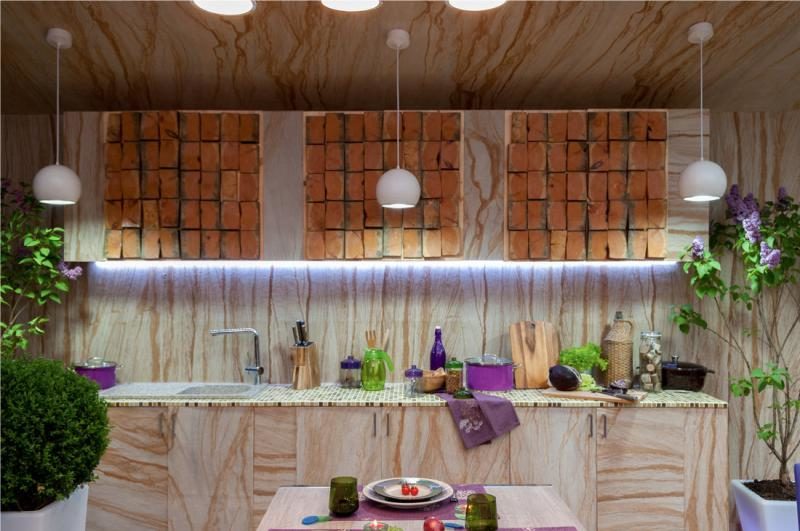

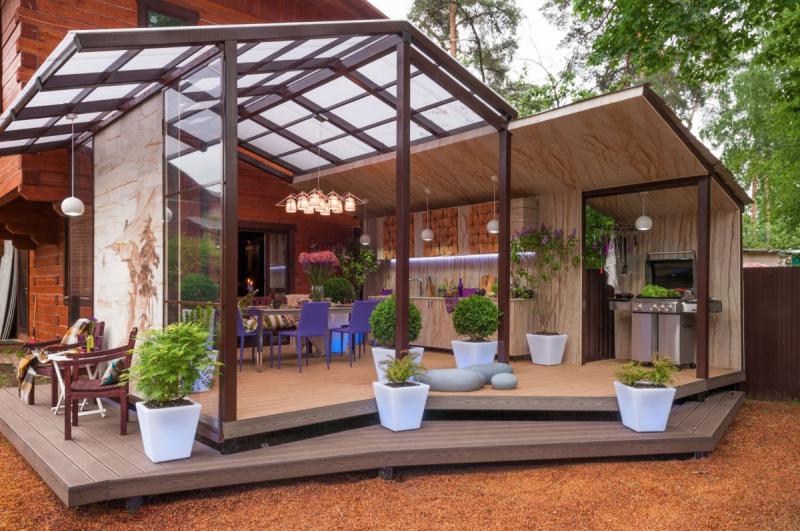

- The closer the summer kitchen is to the house, the more similar both building designs should be.
- If on the site there is an object that is knocked out of the “general picture”, say, a hastily built bathhouse, then the design of the summer kitchen can be planned in such a way that it combines features of the bath and the main house, so the chaotic development will be corrected.
Tip 6. The setting should be particularly practical
In the open kitchen the floor can be trimmed:
- A wooden board, covered with oil or wax for outdoor work (varnish will do worse, because in time it will start to crack and require renewal of the coating).
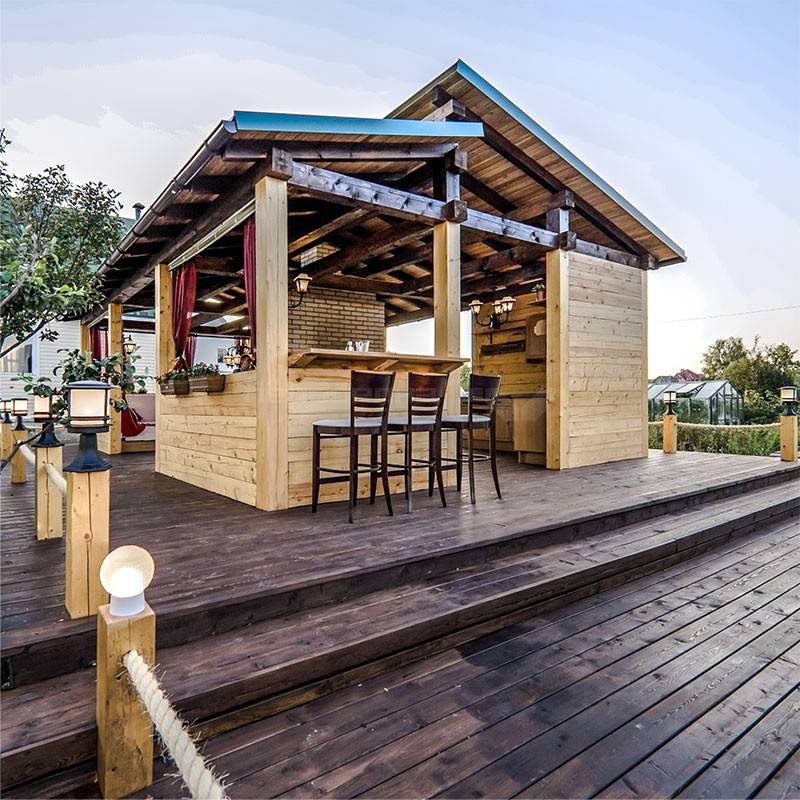
- A terraced board (made of wood-polymer composite).

- Stone or special street tiles.However, such a floor requires a strong foundation and a large budget.

In a closed kitchen you can use the same materials, as well as traditional ceramic tiles and porcelain stoneware .
- By the way, we recommend to refrain from too dark a floor, because on such a floor, crumbs, dirt and puddles of water will be especially noticeable.
- If the floor of the open kitchen has a slight slope (1-2 cm), the rainwater that enters inside will drain itself.
Tip 7. Stick to the rule of the “working triangle” when planning a summer kitchen
In the arrangement of kitchens there is a rule of the so-called “working triangle”, which is based on the fact that the three working zones (sink, stove and refrigerator) should be in reasonable proximity to each other, forming a triangle. Ideally, it should be equilateral. This arrangement of zones in the kitchen is most convenient.
- In the summer kitchen, this rule is not always applicable in its pure form, because the kitchen can be too small, narrow, elongated or irregular in shape. Instead of a plate, it is most often used with a stove, a grill or a brazier, and there may not be a refrigerator. Nevertheless, try to get as close as possible to the ideal arrangement and not build working areas in one line.
So, for example, if in your summer kitchen the source of fire is a brazier, then the washing and preparation area of the food should be installed as close as possible to the exit.
- If the kitchen is small, then you can build an L-shaped kitchen design.For a narrow kitchen (for example, on a veranda), a two-level layout may be appropriate. In the kitchen of the square form, the U-shaped layout will fit better.
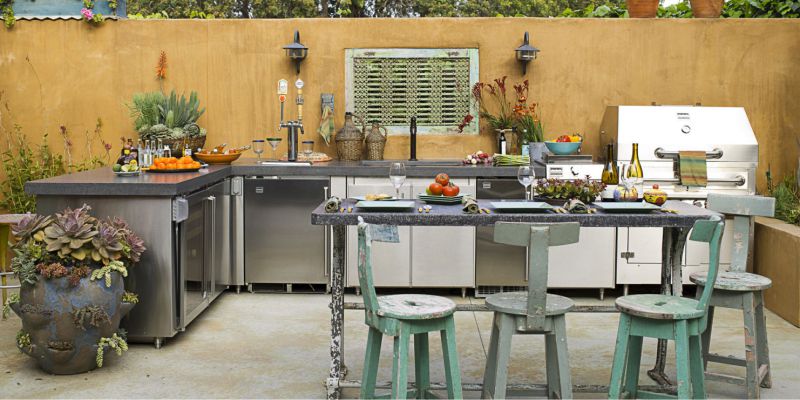
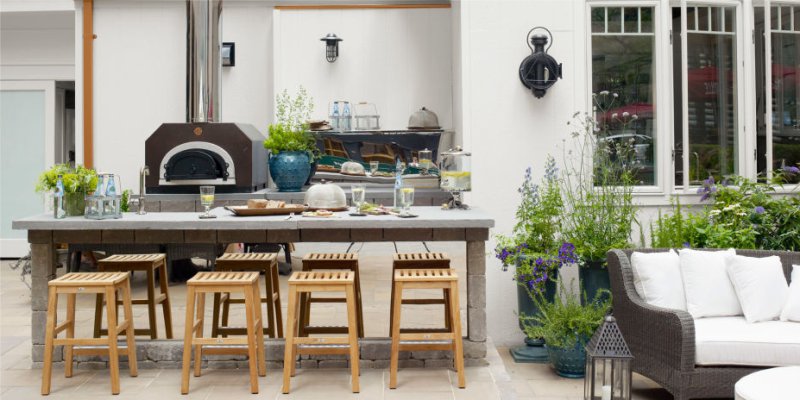
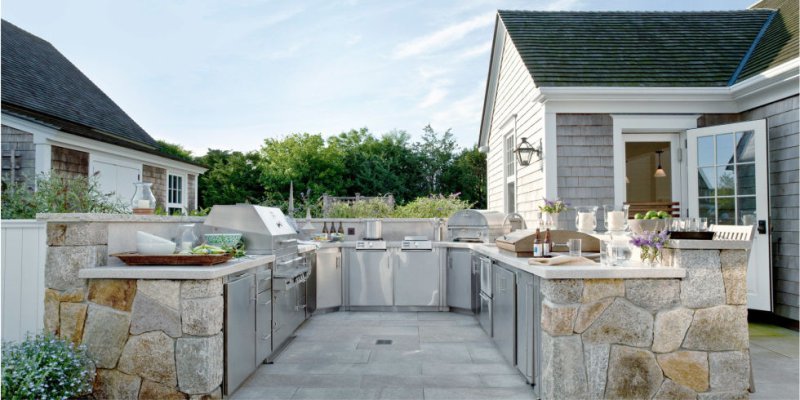
If your summer kitchen is only a one-row layout, then make it more convenient by adding a compact mobile island / peninsula.
Tip 8. The dining area should be at least 2m from the barbecue / stove
Ideally, the distance between the dining table and the barbecue / stove / grill should be about 3 m. In this case, smoke, heat and smells will not disturb the diners, and chips, ashes and sparks will not spoil the view of the dining area.
Tip 9. Use furniture that can withstand outside conditions
Kitchen sets and dining furniture in the summer kitchen should withstand high humidity and temperature changes, therefore, luxurious wooden furniture, furniture from laminated chipboard / MDF, as well as furniture with fabric or leather upholstery should be discarded.
For the summer kitchen the following options are suitable:
- Veneered furniture from MDF;
- Wooden garden furniture (especially suitable are folding structures, which at the end of the summer season can easily be moved to the pantry);
- Forged outdoor furniture;
- Stainless steel furniture (if you do not want to clean the kitchen set for the winter period, choose stainless steel furniture);
- Wicker furniture made of natural vine, rattan or plastic;
- Plastic furniture (eg, polycarbonate).
In the photo below is an example of a summer terrace design with an all-season stainless steel set.

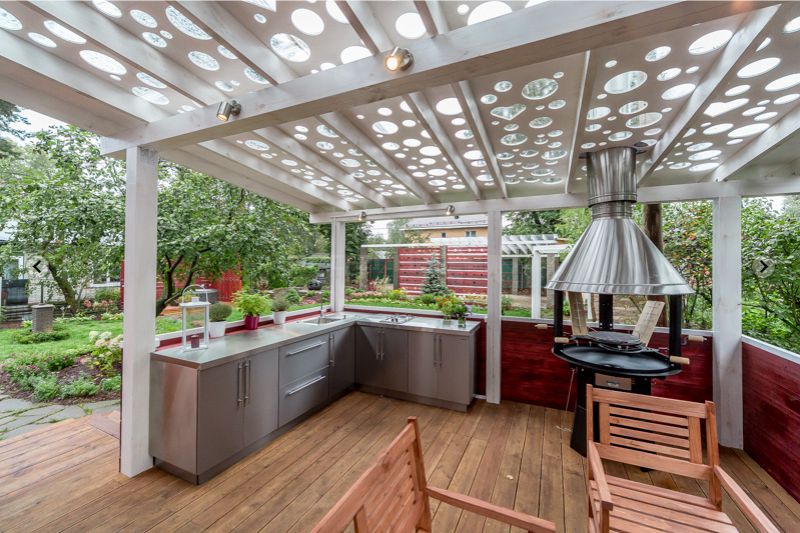
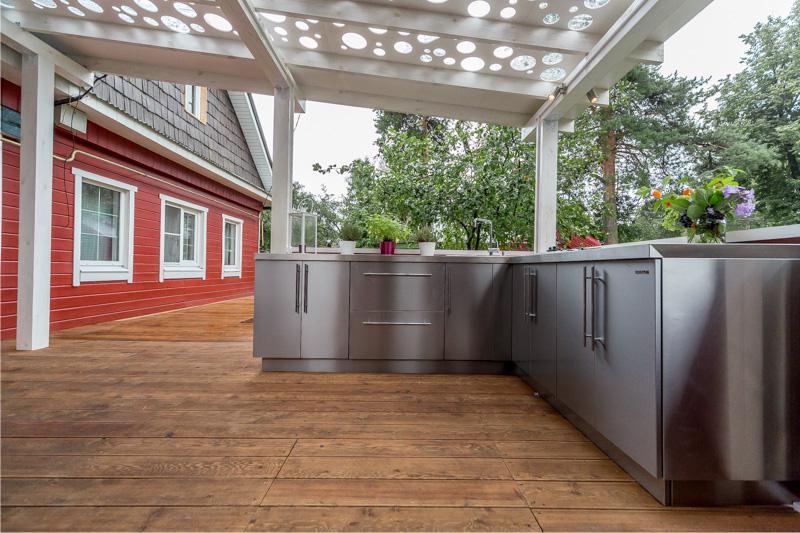
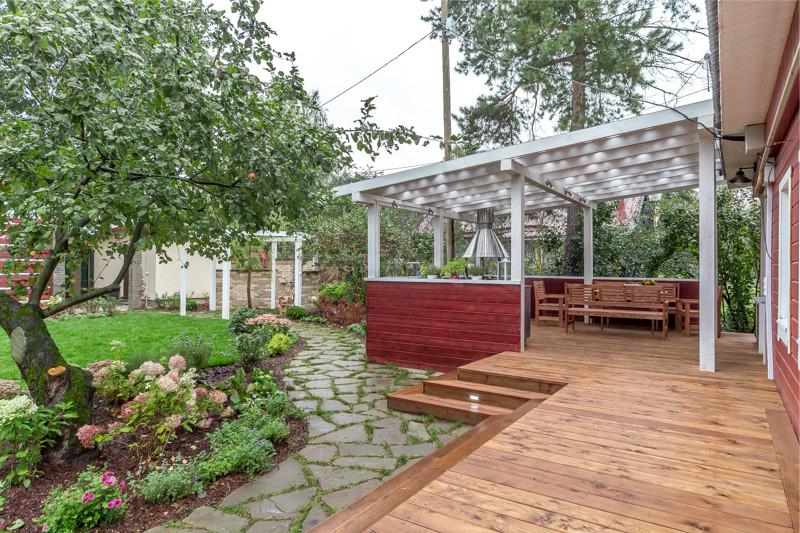

In this collection of photos you can see different ideas on furnishing the summer dining room.

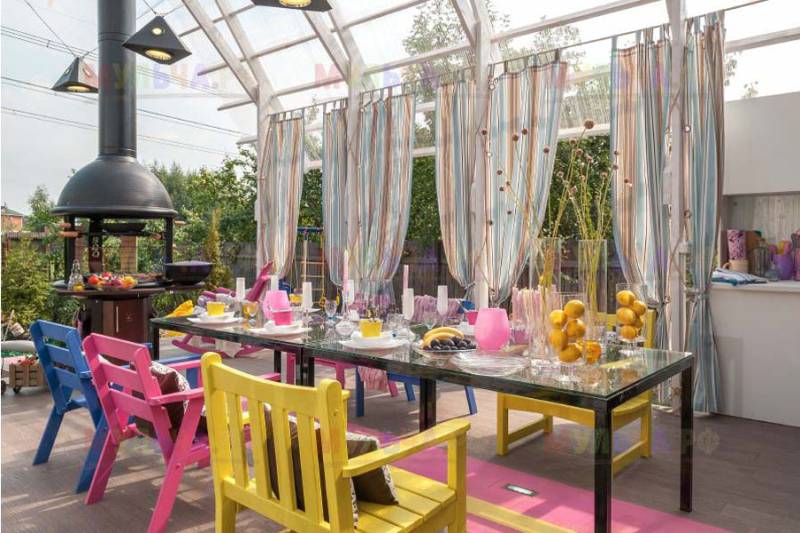

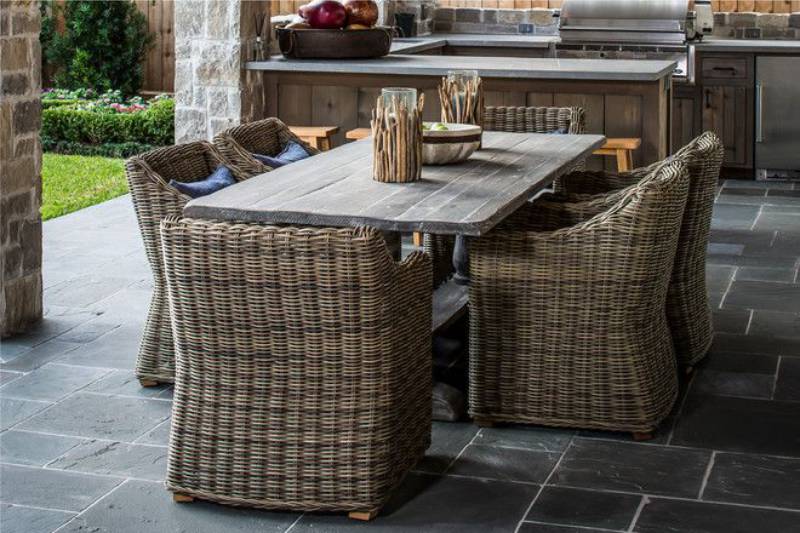
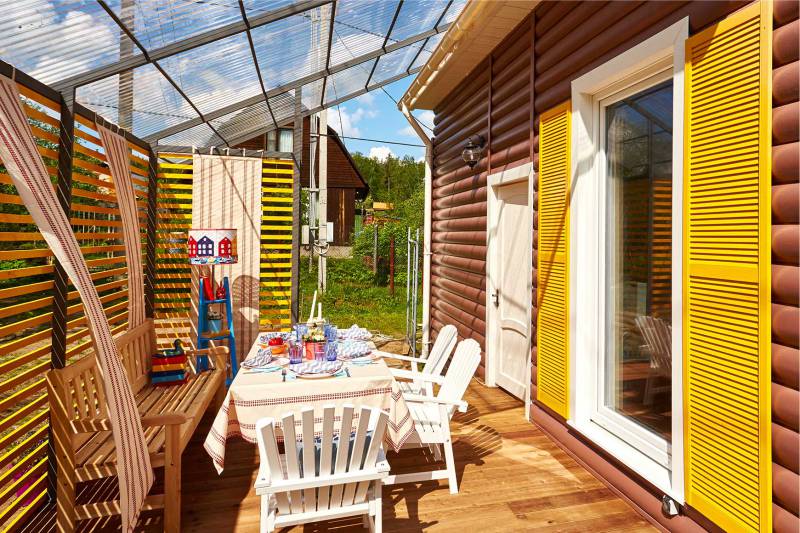
Tip 10. Distribute light sources evenly
Often summer residents forget to give enough attention to lighting the summer kitchen, yet it is with its help that you can create real coziness and comfort.
- Ideally, artificial light in the evening should be soft, uniform and multilevel.To do this, the room should be illuminated not by one chandelier, but by several lamps: floor / hanging lights, wall sconces, spots, hangers, table lamps, floor lamps and / or garlands of light bulbs.
- With the help of light, you can divide the space into zones, for example, in the kitchen and the dining room.So, for instance, you will have the opportunity during the evening meals to hide the working area in the dark and light only a beautiful table.
- To make it comfortable for you to cook in the evenings, set the backlight directly above the working area.If you limit yourself to the lamp behind it, your back will close the light during cooking.
- For lighting an open summer kitchen, metal, plastic, wooden and wicker fixtures with additional protection from water are suitable.Ideally, you can use garden lights.
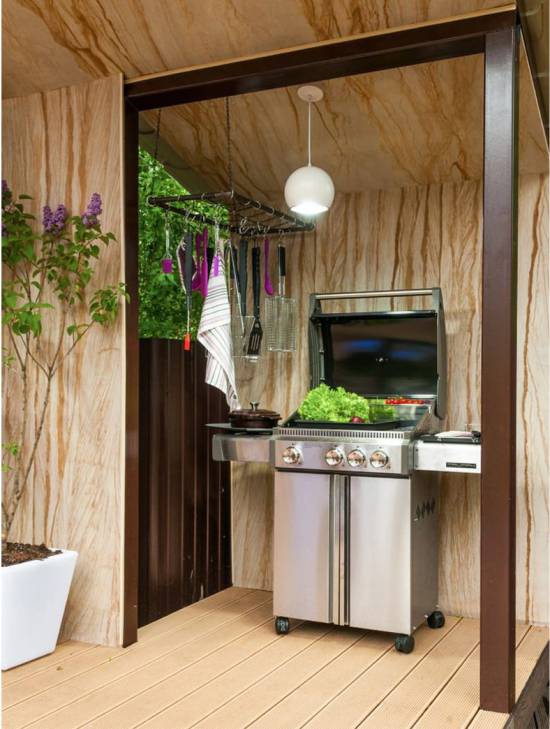
To make it comfortable for you to cook in the evenings, set the backlight directly above the working area.If you limit yourself to the lamp behind it, your back will close the light during cooking.
For lighting an open summer kitchen, metal, plastic, wooden and wicker fixtures with additional protection from water are suitable.Ideally, you can use garden lights.

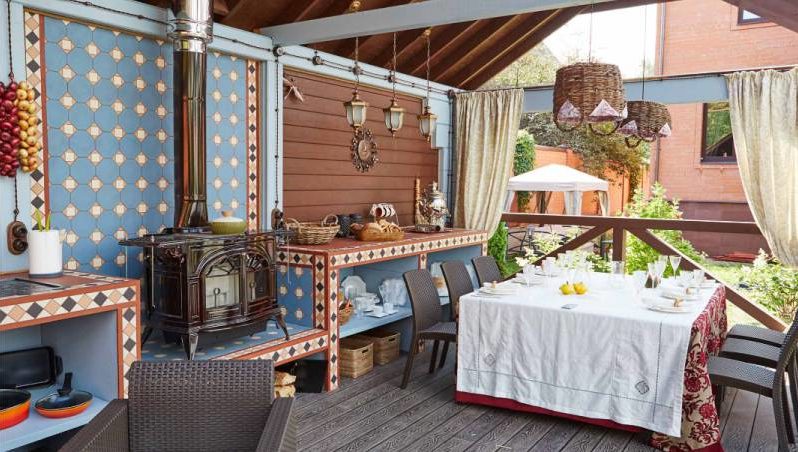
- Around the summer kitchen and along the path you can install lights that work using solar energy.In the afternoon they accumulate energy, and in the evening they automatically turn on. The only drawback is that they give little light, and on cloudy days they do not charge at all.
Tip 11. The greener the surrounding of the building is, the better
- With a hedge, pergolas or curtains surrounded with curly plants, you can make the summer kitchen more secluded and close the view to the unsightly views of the site.
Decorative plantations, flower beds and bushes can denote the boundaries of zones, hide the foundation and simply decorate the summer kitchen and the general view of the territory.
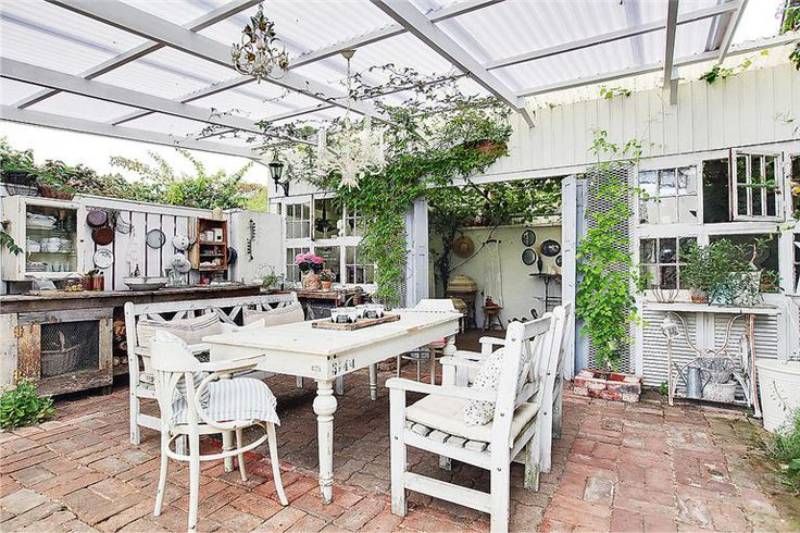

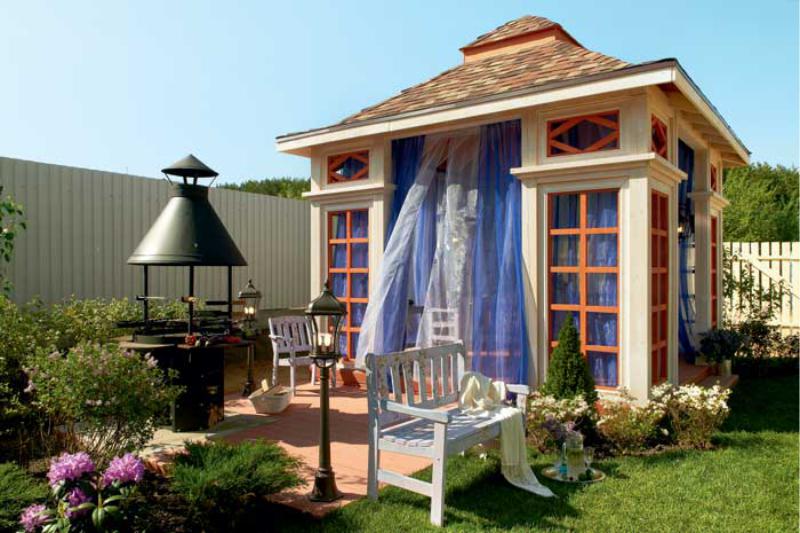

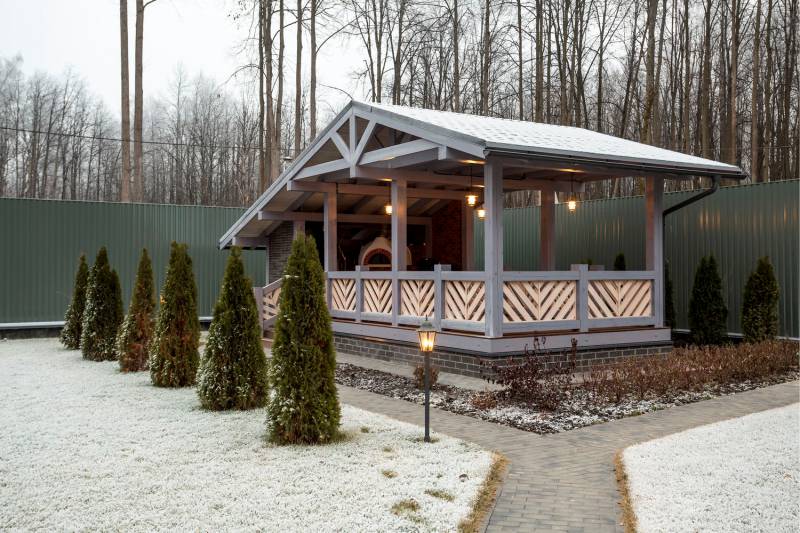
- Plants can also be used to decorate the interior.For example, it can be tall trees in pots and topiaries.
- To save trees on the site, the summer kitchen can be built around or bypassing the trees.The following photos clearly show this technique.

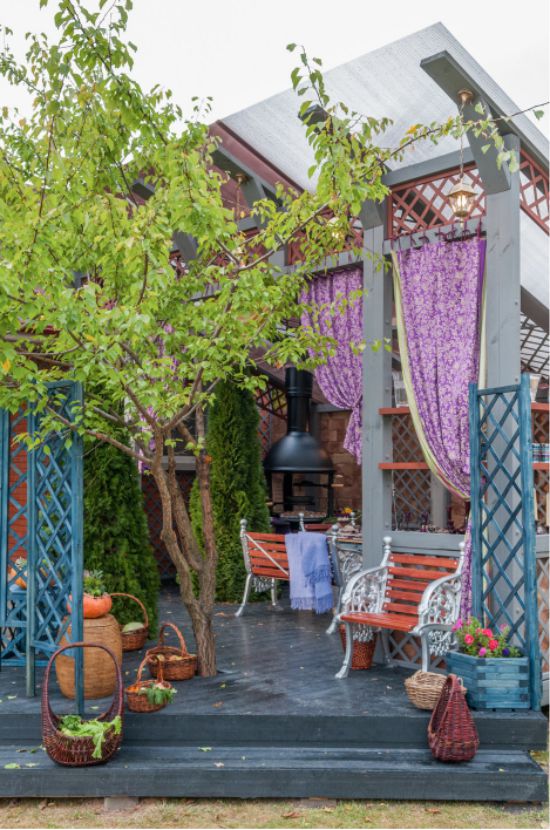
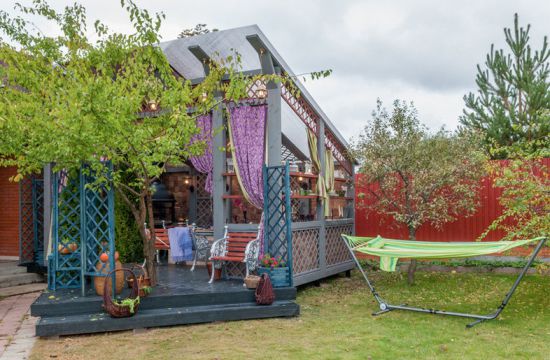
And some more beautiful photos for inspiration
Finally, we suggest that you get the idea of design from a selection of the most original summer kitchens of country cottages and private houses.
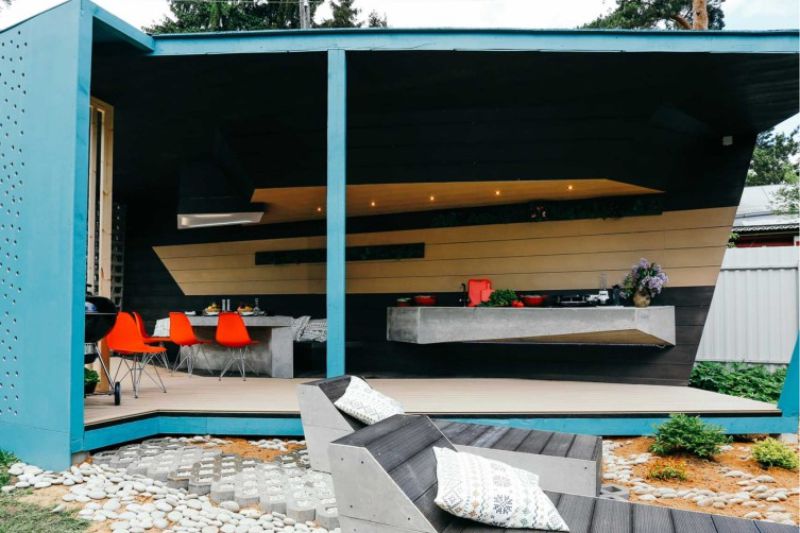
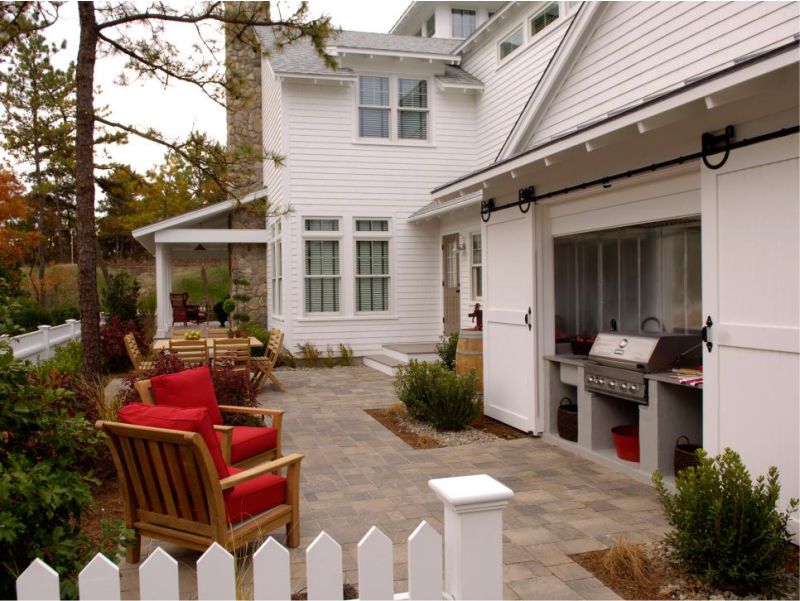
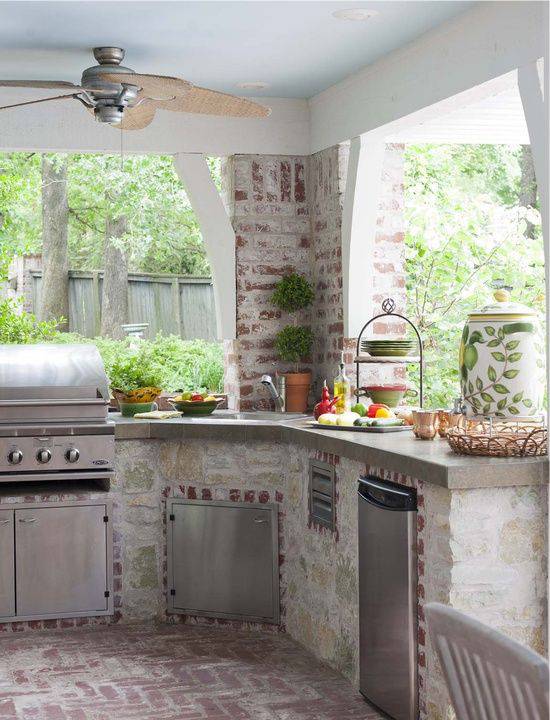
Finally, we present a summer kitchen, which has a whole bunch of interesting details, such as: adjustable for height, noble terrace, bar, sandstone imitation, stained glass windows, as well as a grill with the effect of fire.
